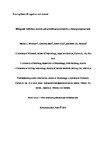Bilinguals’ inhibitory control and attentional processes in a visual perceptual task
| dc.contributor.author | Wimmer, Marina | |
| dc.contributor.author | Marx, C | |
| dc.contributor.author | Stirk, S | |
| dc.contributor.author | Hancock, P | |
| dc.date.accessioned | 2020-04-14T20:31:48Z | |
| dc.date.issued | 2020-05-07 | |
| dc.identifier.issn | 0340-0727 | |
| dc.identifier.issn | 1430-2772 | |
| dc.identifier.uri | http://hdl.handle.net/10026.1/15563 | |
| dc.description.abstract |
The aim was to examine theories of bilingual inhibitory control superiority in the visual domain. In an ambiguous figure task, the ability to reverse (switch) interpretations (e.g., duck-rabbit) was examined in 3-5-year-olds bilinguals and monolinguals (N = 67). Bilingualism was no performance predictor in conceptual tasks (Droodle task, false belief task, ambiguous figures production task) that did not pose inhibitory demands. Bilinguals outperformed monolinguals in the ability to reverse, suggesting superior inhibitory capacity per se. Once reversal was experienced there was no difference in the time it took to reverse or reversal frequency between bilinguals and monolinguals. Bayesian analyses confirmed statistical result patterns. Findings support the established view of bilinguals' superior domain-general inhibitory control. This might be brought to bear by attending the environment differently. | |
| dc.format.extent | 1439-1448 | |
| dc.format.medium | Print-Electronic | |
| dc.language | en | |
| dc.language.iso | en | |
| dc.publisher | Springer Science and Business Media LLC | |
| dc.subject | Bayes Theorem | |
| dc.subject | Child, Preschool | |
| dc.subject | Communication | |
| dc.subject | Deception | |
| dc.subject | Discrimination, Psychological | |
| dc.subject | Female | |
| dc.subject | Humans | |
| dc.subject | Language | |
| dc.subject | Male | |
| dc.subject | Multilingualism | |
| dc.subject | Psycholinguistics | |
| dc.subject | Reaction Time | |
| dc.subject | Recognition, Psychology | |
| dc.title | Bilinguals’ inhibitory control and attentional processes in a visual perceptual task | |
| dc.type | journal-article | |
| dc.type | Journal Article | |
| plymouth.author-url | https://www.webofscience.com/api/gateway?GWVersion=2&SrcApp=PARTNER_APP&SrcAuth=LinksAMR&KeyUT=WOS:000530981700001&DestLinkType=FullRecord&DestApp=ALL_WOS&UsrCustomerID=11bb513d99f797142bcfeffcc58ea008 | |
| plymouth.issue | 4 | |
| plymouth.volume | 85 | |
| plymouth.publication-status | Published | |
| plymouth.journal | Psychological Research | |
| dc.identifier.doi | 10.1007/s00426-020-01333-0 | |
| plymouth.organisational-group | /Plymouth | |
| plymouth.organisational-group | /Plymouth/Faculty of Health | |
| plymouth.organisational-group | /Plymouth/REF 2021 Researchers by UoA | |
| plymouth.organisational-group | /Plymouth/REF 2021 Researchers by UoA/UoA04 Psychology, Psychiatry and Neuroscience | |
| plymouth.organisational-group | /Plymouth/Research Groups | |
| plymouth.organisational-group | /Plymouth/Research Groups/Centre for Brain, Cognition and Behaviour (CBCB) | |
| plymouth.organisational-group | /Plymouth/Research Groups/Centre for Brain, Cognition and Behaviour (CBCB)/Cognition | |
| dc.publisher.place | Germany | |
| dcterms.dateAccepted | 2020-03-27 | |
| dc.rights.embargodate | 2021-5-7 | |
| dc.identifier.eissn | 1430-2772 | |
| dc.rights.embargoperiod | Not known | |
| rioxxterms.versionofrecord | 10.1007/s00426-020-01333-0 | |
| rioxxterms.licenseref.uri | http://www.rioxx.net/licenses/all-rights-reserved | |
| rioxxterms.licenseref.startdate | 2020-05-07 | |
| rioxxterms.type | Journal Article/Review |


